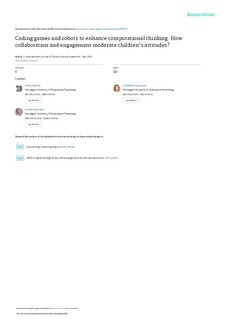| dc.contributor.author | Sharma, Kshitij | |
| dc.contributor.author | Papavlasopoulou, Sofia | |
| dc.contributor.author | Giannakos, Michail | |
| dc.date.accessioned | 2019-10-04T12:17:00Z | |
| dc.date.available | 2019-10-04T12:17:00Z | |
| dc.date.created | 2019-06-14T13:13:48Z | |
| dc.date.issued | 2019 | |
| dc.identifier.citation | International Journal of Child-Computer Interaction. 2019, 21 65-76. | nb_NO |
| dc.identifier.issn | 2212-8689 | |
| dc.identifier.uri | http://hdl.handle.net/11250/2620359 | |
| dc.description.abstract | Collaboration and engagement while coding are vital elements for children, yet very little is known about how children’s engagement and collaboration impact their attitudes toward coding activities. The goal of the study is to investigate how collaboration and engagement moderate children’s attitudes about coding activities. To do so, we designed an study with 44 children (between 8 and 17 years old) who participated in a full-day coding activity. We measured their engagement and collaboration during the activity by recording their gaze, and their attitudes in relation to their learning, enjoyment, team-work and intention by post-activity survey instruments. Our analysis shows that there is a significant moderating effect of collaboration and engagement on children’s attitudes. In other words, highly engaging and collaborative coding activities significantly moderate children’s attitudes. Our findings highlight the importance of designing highly collaborative and engaging coding activities for children and quantifies how those two elements moderate children’s attitudes. | nb_NO |
| dc.language.iso | eng | nb_NO |
| dc.publisher | Elsevier | nb_NO |
| dc.rights | Attribution-NonCommercial-NoDerivatives 4.0 Internasjonal | * |
| dc.rights.uri | http://creativecommons.org/licenses/by-nc-nd/4.0/deed.no | * |
| dc.title | Coding games and robots to enhance computational thinking: How collaboration and engagement moderate children’s attitudes? | nb_NO |
| dc.type | Journal article | nb_NO |
| dc.type | Peer reviewed | nb_NO |
| dc.description.version | acceptedVersion | nb_NO |
| dc.source.pagenumber | 65-76 | nb_NO |
| dc.source.volume | 21 | nb_NO |
| dc.source.journal | International Journal of Child-Computer Interaction | nb_NO |
| dc.identifier.doi | 10.1016/j.ijcci.2019.04.004 | |
| dc.identifier.cristin | 1704987 | |
| dc.relation.project | Norges forskningsråd: 290994 | nb_NO |
| dc.relation.project | Norges forskningsråd: 255129 | nb_NO |
| dc.description.localcode | © 2019. This is the authors’ accepted and refereed manuscript to the article. Locked until 7.5.2021 due to copyright restrictions. This manuscript version is made available under the CC-BY-NC-ND 4.0 license http://creativecommons.org/licenses/by-nc-nd/4.0/ | nb_NO |
| cristin.unitcode | 194,63,10,0 | |
| cristin.unitname | Institutt for datateknologi og informatikk | |
| cristin.ispublished | true | |
| cristin.fulltext | postprint | |
| cristin.qualitycode | 1 | |

